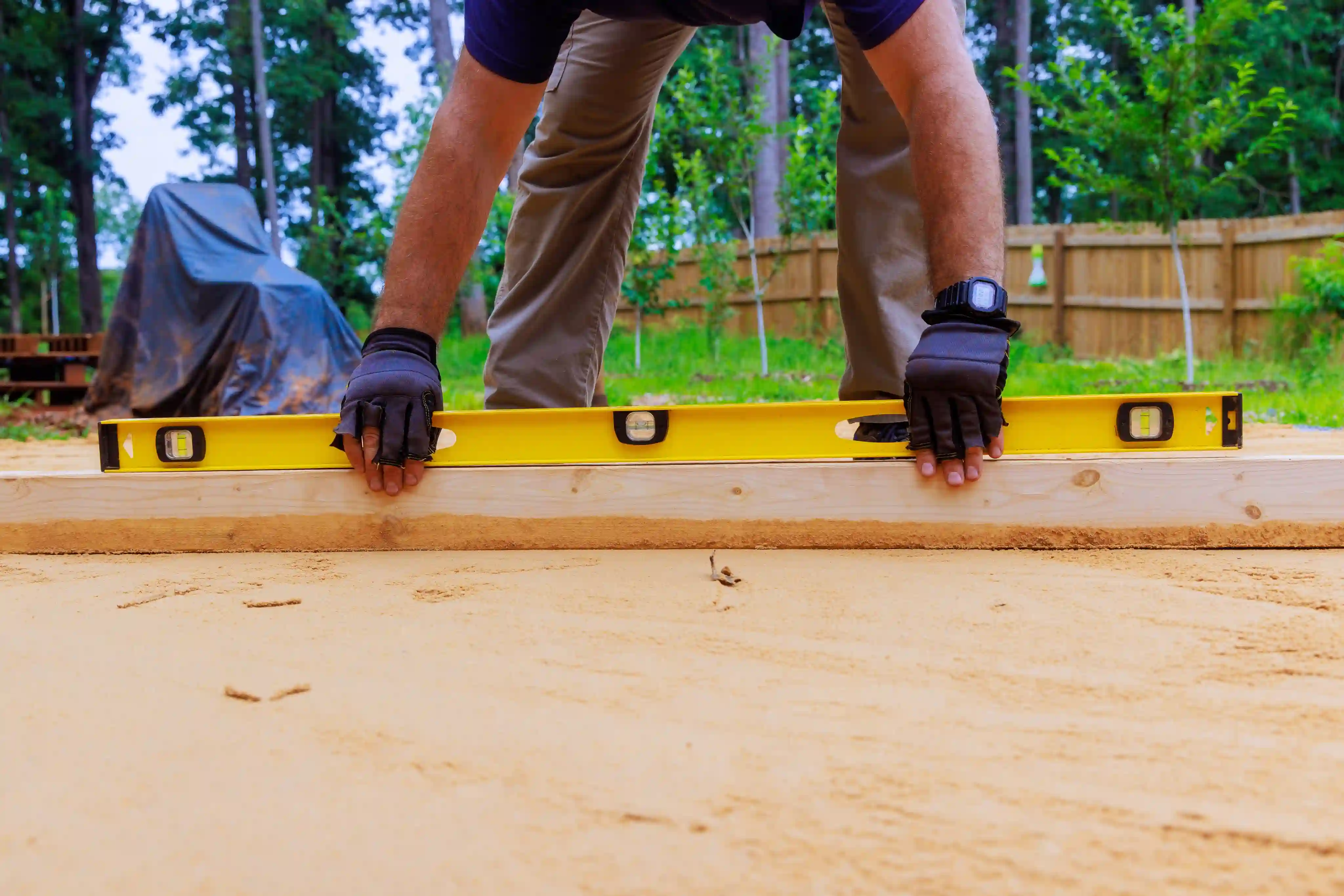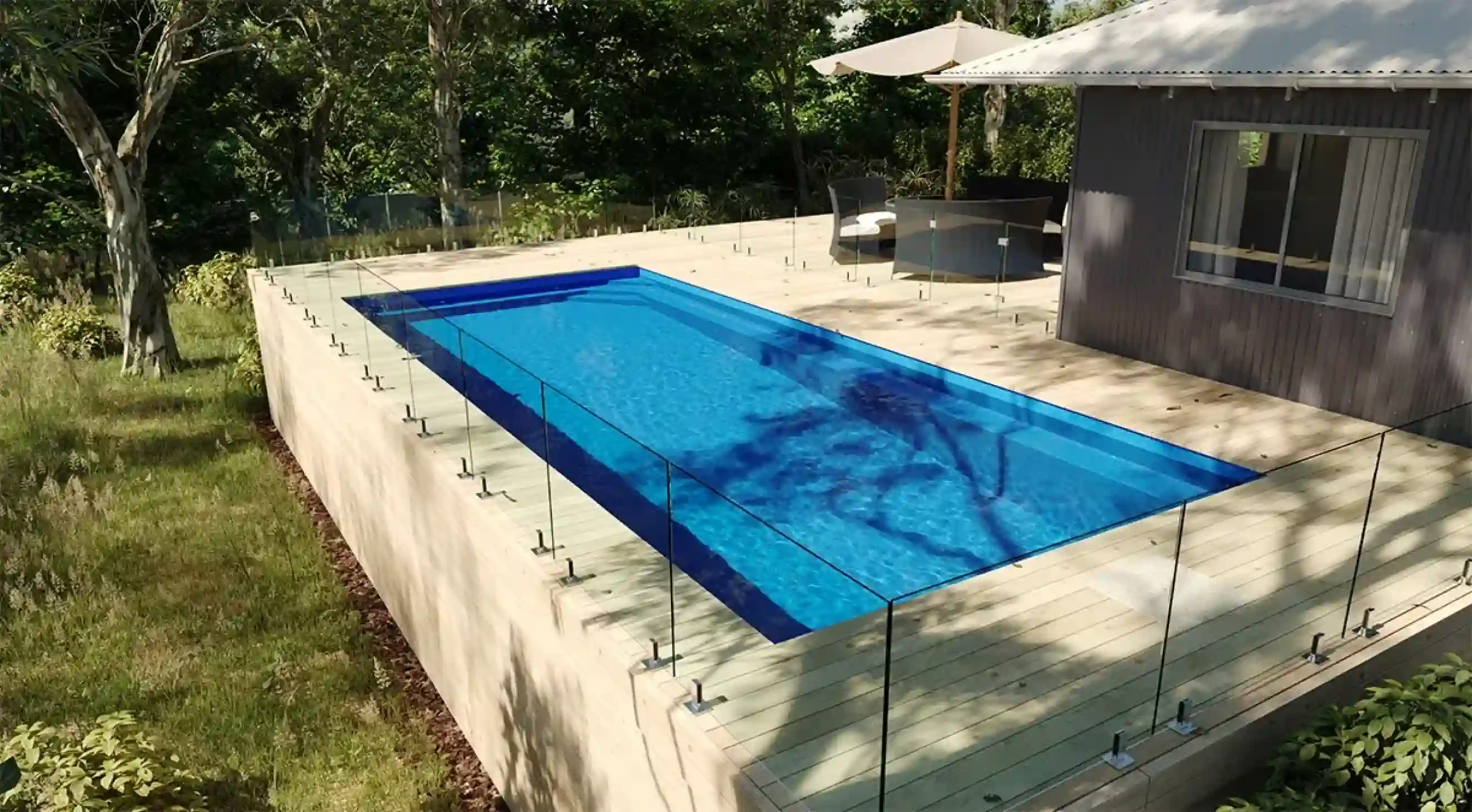Pool Buying Guide
The Essentials You Must
Know Before Buying A Pool

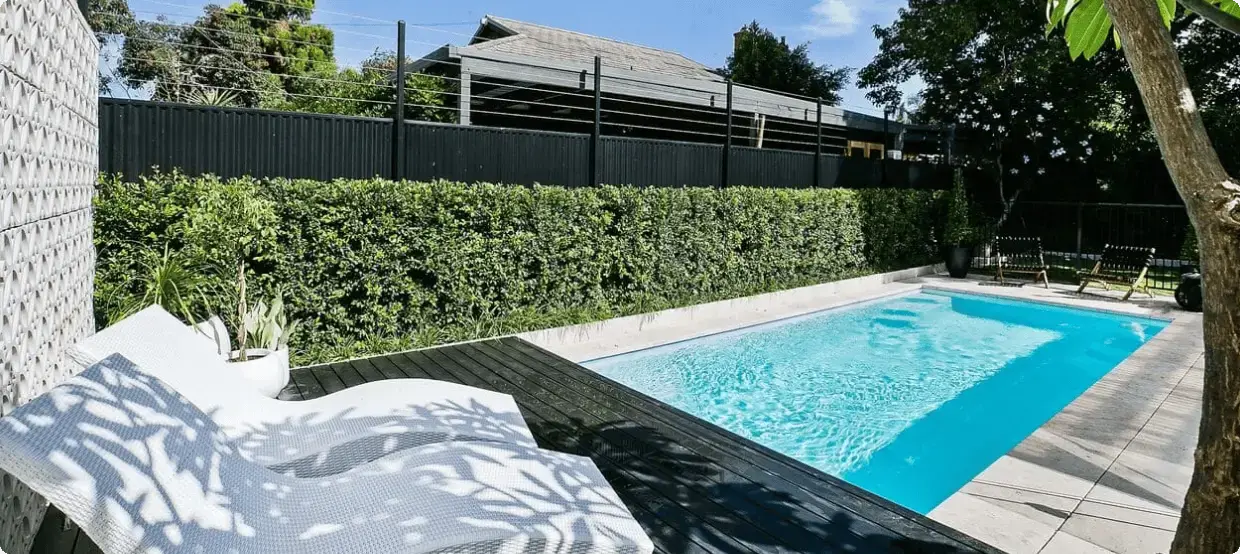
TABLE OF CONTENTS
- What Size of Pool will Suit Me Best
- What is Normally Included with Pool Installation?
- What Does a Pool Cost?
- Can Fibreglass Pools Be ...
- How Long Will It Take Before I Can Dive Into My New Pool?
- What Is The Best Pool Colour For Me?
- What is better? Chlorine, Saltwater or Mineral Pools
- What Pump Do I Need? Single, Two, Or Variable Speed
- What is the difference between a media filter and cartridge filter?
- The Essential Big Three
- Are Gas and Electric Pool Heaters Expensive to Operate?
- What’s the Difference Between Halogen and LED Pool Lights?
- The Difference Between a Manual Vacuum, Suction Cleaner and Robotic Cleaner
- What is a handover kit and what is in it?
- Is That Everything? What About the Other Stuff?
TABLE OF CONTENTS
- What Size of Pool will Suit Me Best
- What is Normally Included with Pool Installation?
- What Does a Pool Cost?
- Can Fibreglass Pools Be ...
- How Long Will It Take Before I Can Dive Into My New Pool?
- What Is The Best Pool Colour For Me?
- What is better? Chlorine, Saltwater or Mineral Pools
- What Pump Do I Need? Single, Two, Or Variable Speed
- What is the difference between a media filter and cartridge filter?
- The Essential Big Three
- Are Gas and Electric Pool Heaters Expensive to Operate?
- What’s the Difference Between Halogen and LED Pool Lights?
- The Difference Between a Manual Vacuum, Suction Cleaner and Robotic Cleaner
- What is a handover kit and what is in it?
- Is That Everything? What About the Other Stuff?
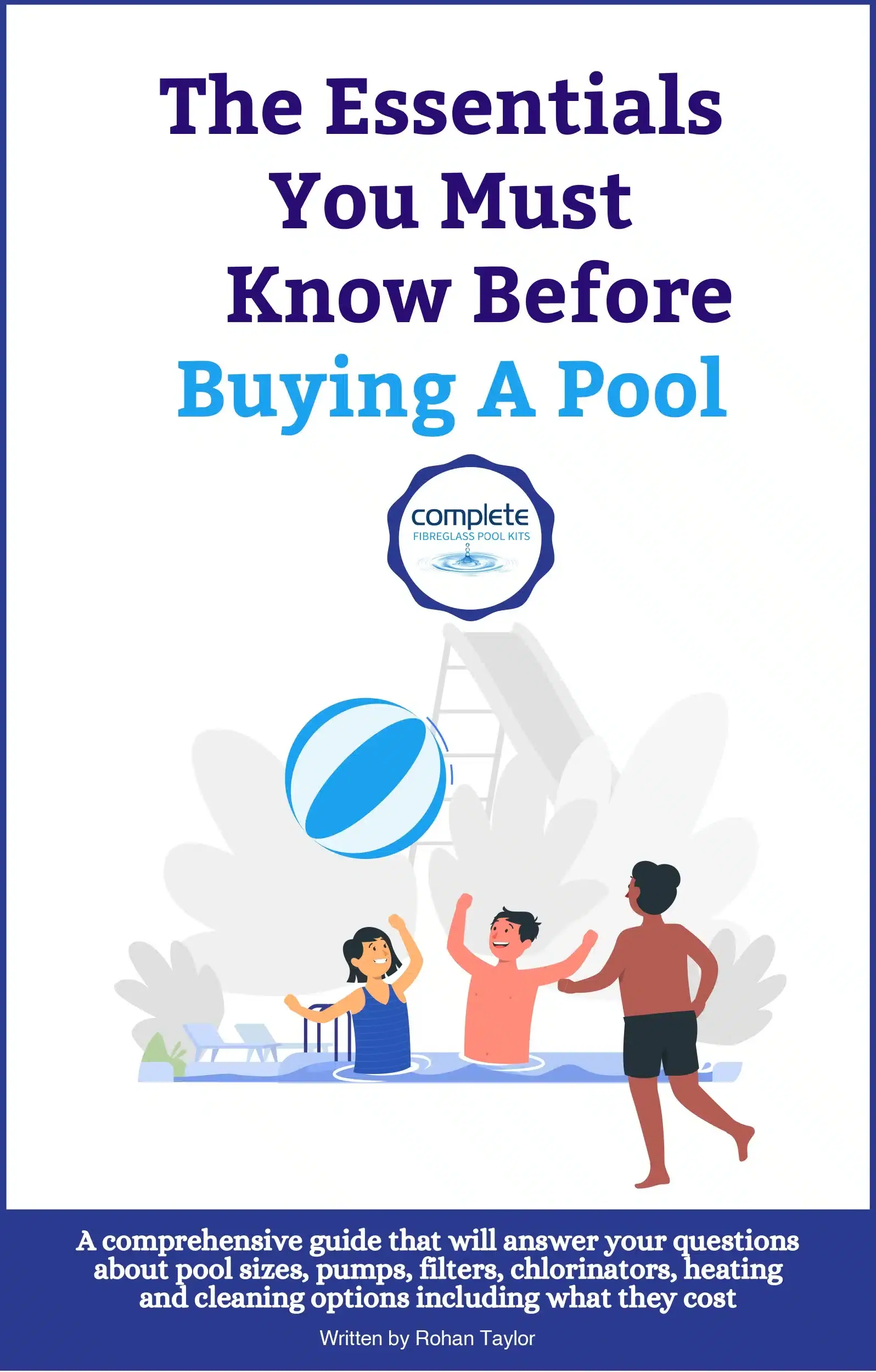
DON'T HAVE TIME TO READ IT NOW?
Download the PDF
and read it later.
Introduction
If you are like most future pool buyers, you are probably wondering what is the difference between a single speed and multi speed pump, media and cartridge filters, robot cleaners and suction cleaners, and that’s just the first couple of questions. What about the pool size? How much does all this cost?
At Complete Fibreglass Pool Kits, we love it when our customers ask a lot of questions and we love answering them. So, to save you loads of research time, we have put together an e-Guide answering the most common questions we are asked by
pool buyers just like you. Even if you buy elsewhere or decide a concrete pool is right for you, we are dedicated to providing honest and transparent information without sales spin and bias.
This guide doesn’t go into the details about installation, materials pools are made from, warranties, pool kits versus buying from a pool builder and ongoing costs of ownership and maintenance. We covered that in our popular “An Unbiased Comparison Between Vinyl Liner, Concrete and Fibreglass Pools” e-Guide. If you are still weighing up whether concrete or fibreglass is best for you, we recommend having
a read
As a quick refresher, the differences between pool types are summarised in an easy-to-read table below.

Rohan Taylor
Author
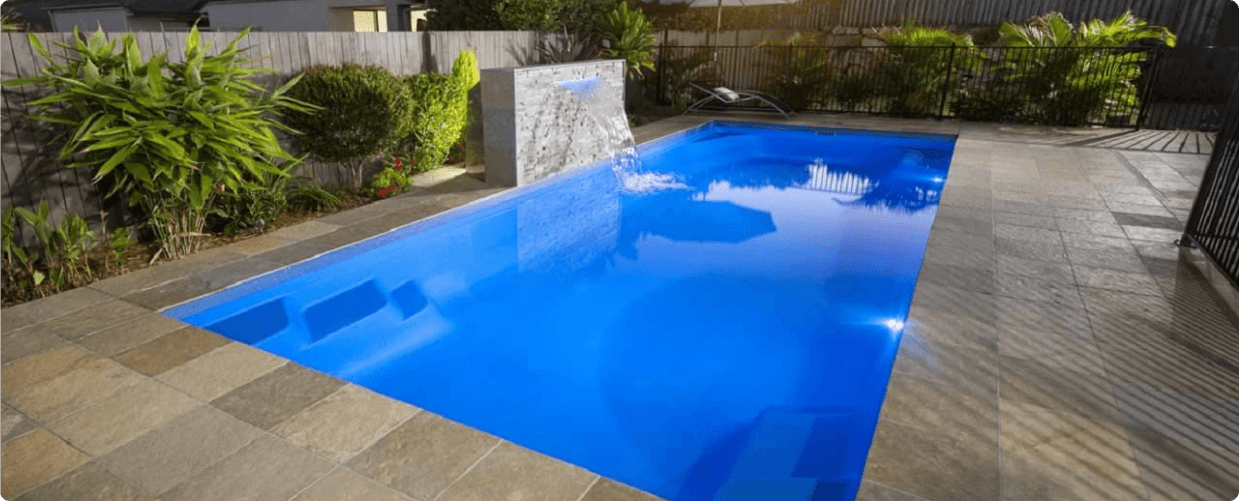
Brett Tribe
New South Wales
What Size of Pool will Suit Me Best
Our “An Unbiased Comparison Between Vinyl Liner, Concrete and Fibreglass Pools” e-Guide has thought provoking questions that is a good starting point. We’ll assume you have memorised those pages and we’ll dive in (yes, pun intended. We are Dad’s after all) with some more thought- prompters.
When considering pools, always check that the dimensions are for the interior of the pool. Sometimes, brochure measurements include the top lip (called the coping) of the pool which can be up to 200mm wide. Times by two sides and a 3.4m wide pool might only be 3m internally which is really disappointing to discover as the pool is being installed. Not sure? Ask to see the engineer- approved pool specifications.
At Complete, all our pool measurements are internal and are shown on our website via our pool pages.

If you have loads of space, it can be tempting to go for the biggest pool possible. We grew up on quarter acre blocks swimming in massive pools. Today, blocks are smaller, houses are bigger and backyards more compact. Compact pools add plenty of value to your home and your kids will be happy with a pool no matter the size. A bigger pool does not mean bigger fun!
When you think about your future pool, what vision comes to mind? Teaching the kids to swim, laps before work in the morning or a visual feast for the eyes while having dinner from the alfresco area? Do you have the space to match your vision?
Ten adults squeezed around a 6 person table for dinner while the 10mx4m pool sparkles can quickly wear thin. Favour entertaining area over pool size as this is where us adults will spend most of our time. Young kids that need watching in the pool? Make sure you have room for a couple of comfy deck chairs. You still get plenty of Wow Factor with a smaller pool, particularly with the water features, extra lighting and deck jets you can afford with the reduced cost of going smaller.
Spa blowers, pumps, filters, heat pumps and chlorinators take up space and it is ideal if they are out of sight. Well designed water features can also house your filtration equipment which is a great space saver.
Compact doesn’t mean shallow. Plunge (4.5m x 2.7m) pools can be 1.65m deep. Not only efficient to maintain, a 1.65m pool is plenty deep enough for all activities except installing a 10m diving platform!
If the kids have flown the coop, think of future grandkids who will love a shallow end at first and deep end as they grow older. Keep in mind the future buyer of your home should you sell. While you have plenty of time and enjoy spending time maintaining an extra large pool, it could be a deal breaker for a young, time poor family who want the fun without the time and cash cost of maintaining a large pool.
Sometimes, despite rubbing the lantern and asking for three wishes, they do not come true. Check with your council early on about easements, set back requirements, heritage listed trees and buildings and Dial Before You Dig to find out where your sewer and water lines are. There is nothing worse than finding your ideal pool, designing the whole backyard only to find out you need a different pool due to an illplaced sewer line.
Once you have worked through what size is the most realistic for you, you just need to pick a shape!

JL O’Donnell
Western Australia
What is Normally Included with Pool Installation?
Whether you buy a fibreglass pool shell and equipment from us or through a pool builder, the installation process is the same. A basic installation includes everything that is needed to put your pool shell in the ground in a level and stable position and connected to your pump, filter and chlorinator.
It is super important that your pool installer provides you with an itemised inclusion list when providing a quote. As you can see below, there are many other expenses associated with pool installation which can add up to thousands of dollars. We’ve all had an experience where we thought we were buying an “all inclusive dinner” package only to find out all too late the drinks and dessert were extras as you are sitting at the table. It can be the same with pools.
Prefer to see images to make sense of the basic installation process?
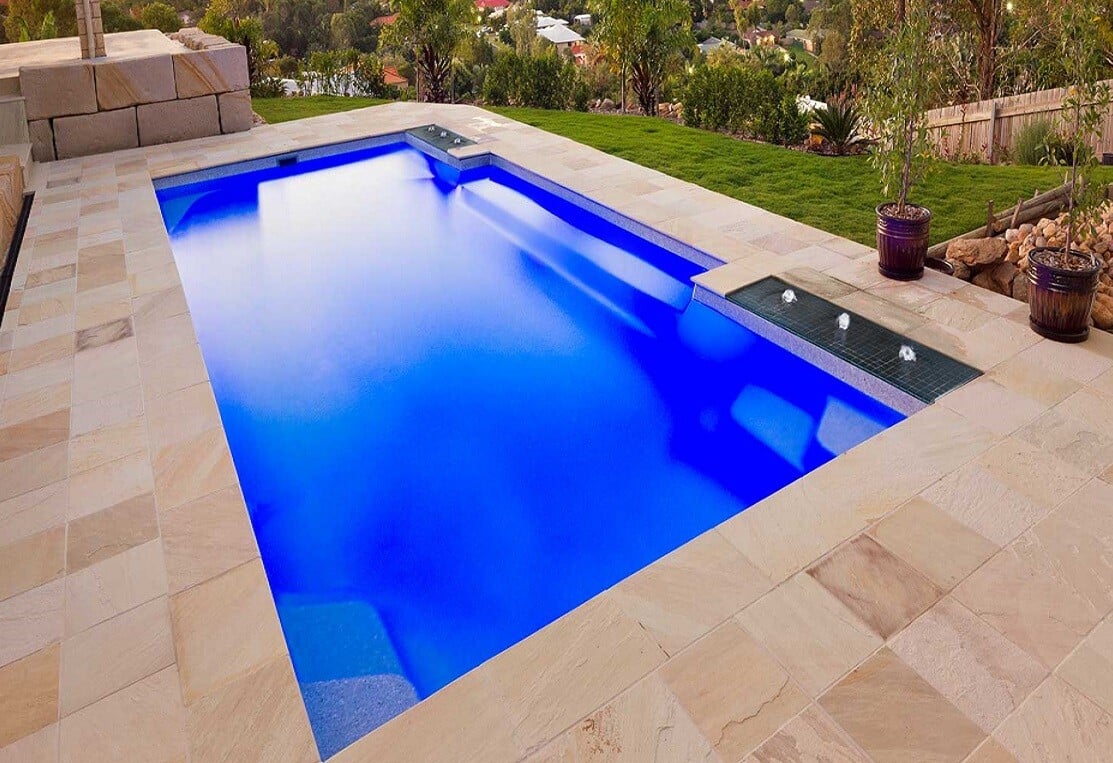
Bethany Gobbo
Victoria
What Does a Pool Cost?
There are lot of different factors that affect the cost of a fibreglass pool. The single biggest influence on cost is the size and the depth of pool you choose, rather than the actual shape. In our “An Unbiased Comparison Between Vinyl Liner, Concrete and Fibreglass Pools” e-Guide, we talk about costs in a lot more detail.
The starting point for a basic fibreglass pool installation, including the shell and equipment, by a pool builder is $35,000 for a small fibreglass pool (4.5m x 2.7m) and up to $80,000 for an extra large fibreglass pool (11m x 4m) assuming good site access and soil type.
Basic installation includes the pool, pump, filter and chlorinator being installed to be compliant with Australian Standards. Lights, paving, landscaping, retaining walls, patios, water features, pool fencing and additional equipment like cleaners and heating are additional costs from there. Pool buyers usually spend an additional $7,000 to $20,000 on these items.
Soil type, trees, infrastructure in the ground and site access all impact costs. Ask for an itemised quote when getting pricing so you can see exactly what the costs are.
Are you wanting to save money so you can afford some of the extras? Buying a fibreglass pool kit with an assisted installation through a licenced installer will generally save you at least $5,000, and up to $20,000, for a medium sized pool compared to full installation through a pool builder
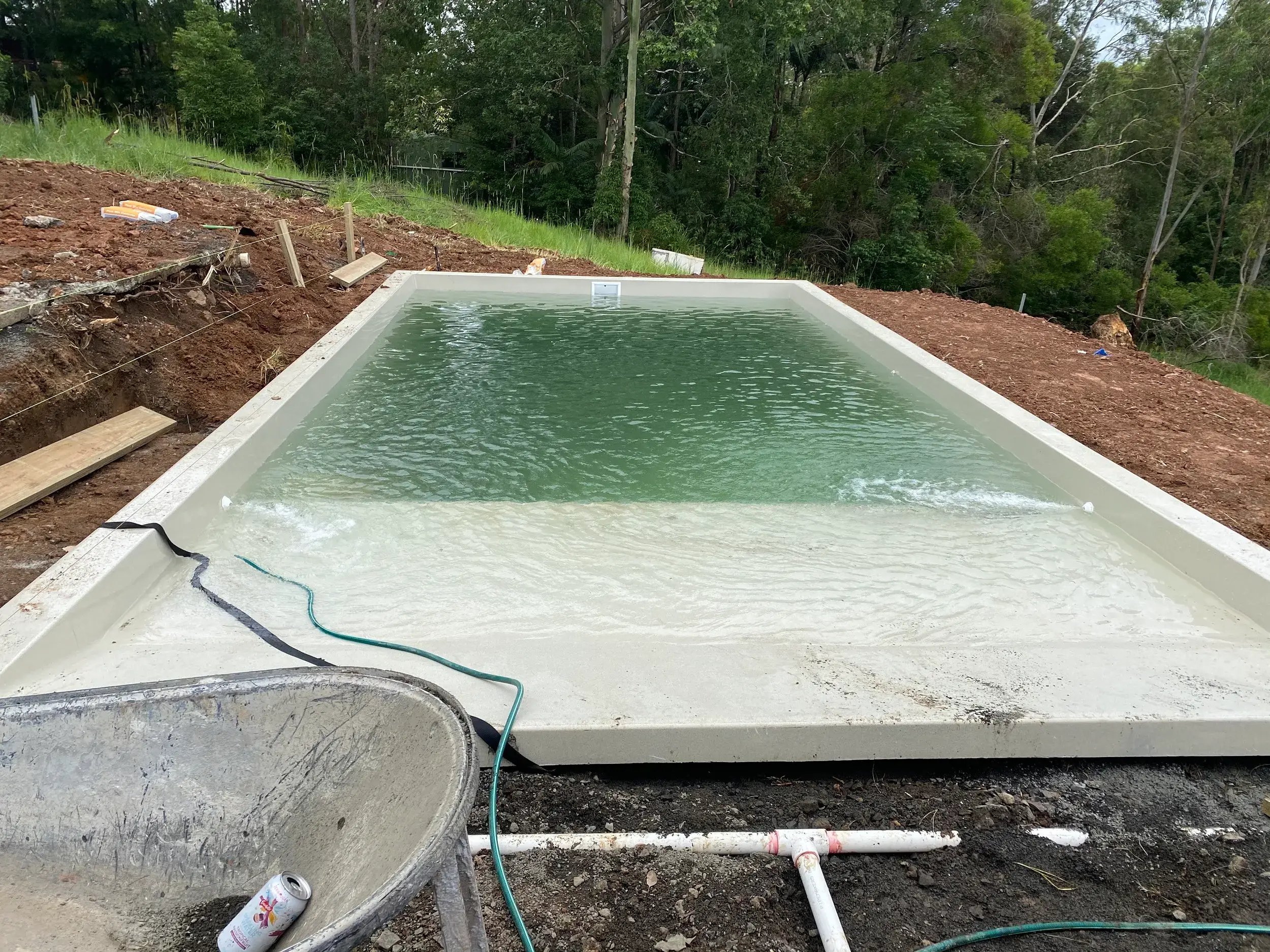
Gillian Darr
Queensland
Can Fibreglass Pools Be ...
…installed on sloping sites?
Yes. Today’s fibreglass pools are incredibly strong and can be installed on sloping sites. To make sure your pool is level you may need retaining walls. You can spend anywhere between $2,000 and $20,000+ on retaining walls depending on how much retaining is needed. If the ground where your pool is going has a slope, or your land is significantly higher or lower than your neighbours, arrange a retaining wall quote early in your process so you know what cost you are up for.
...be lifted over two story houses?
Yes. We’ve yet to find a backyard that a fibreglass pool cannot be crane lifted in to. It is a question of how big a crane will you need to be able to reach over your house from the road and into your backyard. Crane hire costs are usually between $300 and $1,200. If your street is a little bit busy, you may need the services of a traffic management company which can cost several thousand dollars as well. Read More Here.
…installed with a really narrow side of house access?
Yes. Whether concrete or fibreglass, a decent amount of excavated soil will need to be removed. If your side access is a very narrow .5m, your earth workers will need smaller equipment which adds to excavation and dirt removal time. As they say, time is money. As a rule of thumb, anything less than 3m, the cost will start to increase. As a side note, make sure your quote includes dirt removal. The further you are from a dumping point, the higher the cost will be.
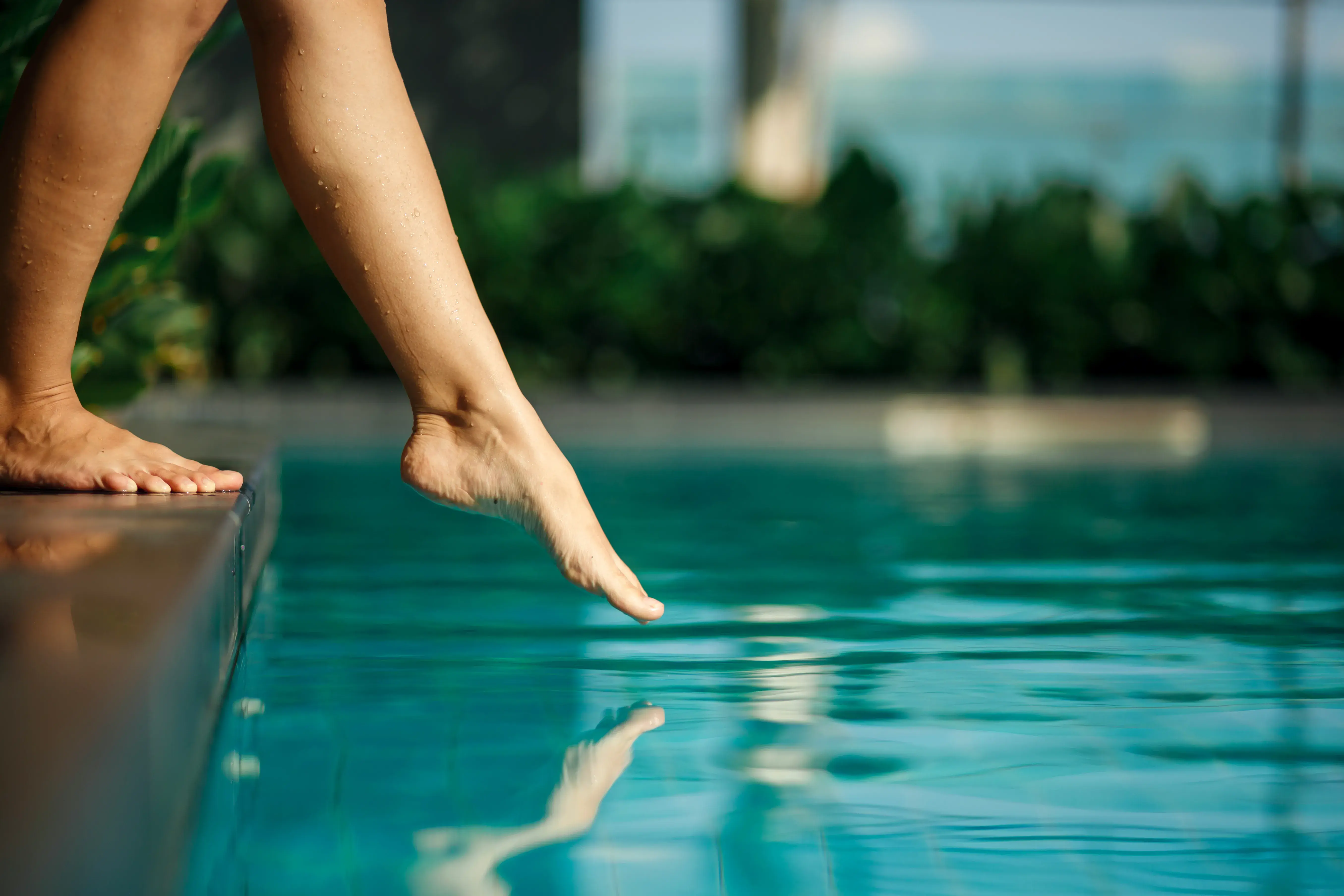
Shannon O’Shanassy
New South Wales
How Long Will It Take Before I Can Dive Into My New Pool?
In our “An Unbiased Comparison Between Vinyl Liner, Concrete and Fibreglass Pools” eGuide, we talk about installation timeframes in detail. Let’s have a quick overview though.
Depending on where you live, local council approvals can take between 3 and 6 weeks for any type of pool. Manufacturing time for your fibreglass pool shell is usually between 4 weeks (winter) and up to 12 weeks (summer). With good planning, you can obtain council approval while your shell is being manufactured. As fibreglass pool shells are made in climate -controlled factories, you won’t experience manufacturing delays due to rain and wind.
Basic installation can be completed in as little as 5 days. As a rule of thumb, allow at least two weeks for installation. Pool fences, full paving and landscaping can take between 3 days and 3 weeks depending on what you are getting done. If you want to make sure your pool is ready for the first day of summer, arrange installation over winter and spring. Weather does not impact fibreglass pool installation as much as a concrete pool so a winter installation is a great time to install your pool.
These timeframes assume a level back yard, good soil conditions and 3m side of house access. If you need retaining walls, rocks dug out, trees cut down etc, get a quote so you understand the additional time these steps will take. As with any project, work out the timeframe and then add a week for the unforeseen things that tend to pop up!
Pool Installation Timeframes

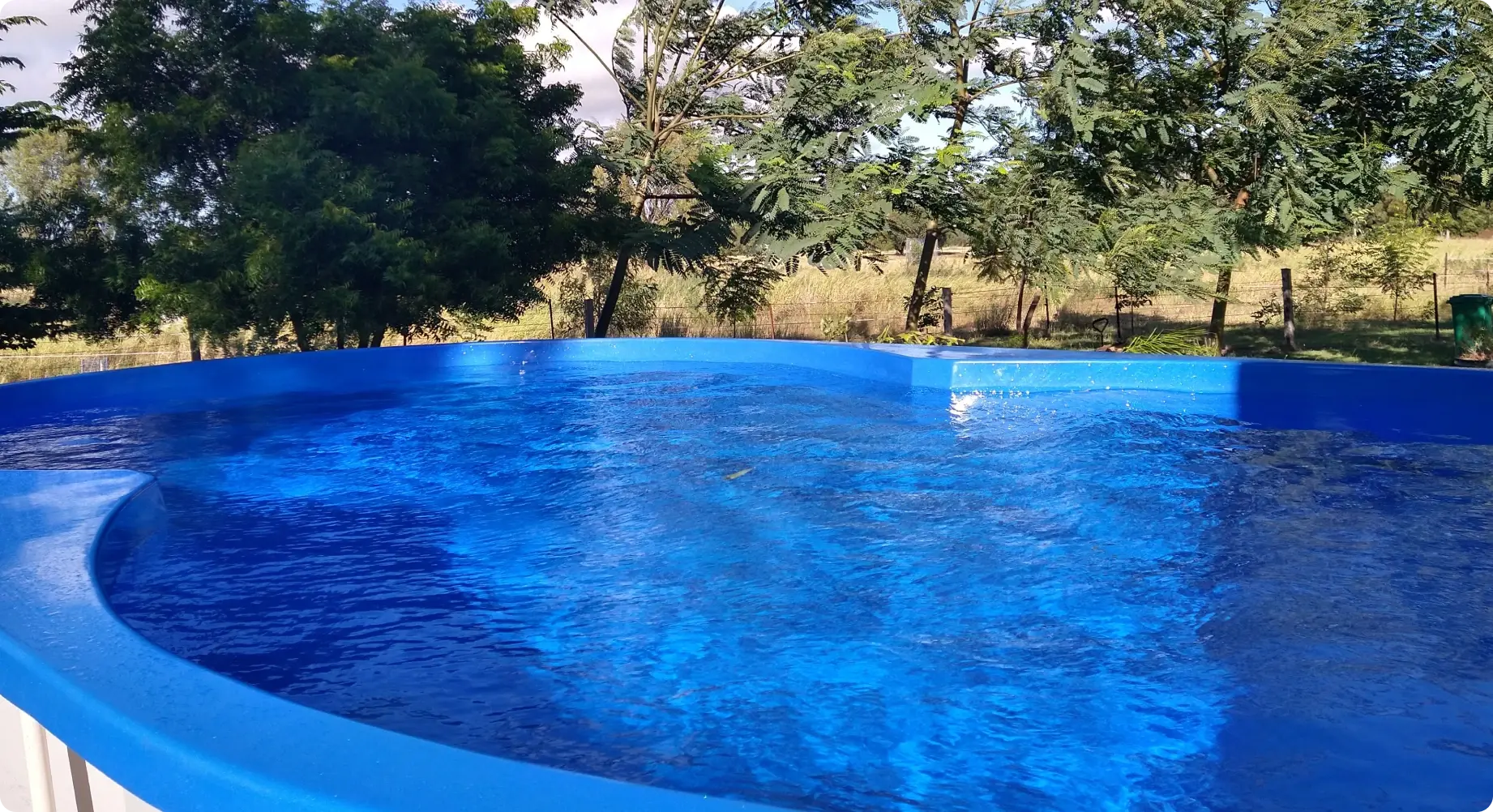
Tina van Dam
Western Australia
What Is The Best Pool Colour For Me?
The range of colours for fibreglass pools is amazing. Everything from a sparkling shimmer finish gelcoat through to our manufacturers exclusive AquaGuard-X™ Marbletech™ gelcoat upgrade. What’s gelcoat? Yep, you guessed right. We cover this in detail in our Comparison e-guide! We have 20 different colours in our range. As you can see below, the colour does make a big difference to your pools appearance and the water colour.
So, how do you choose? 
Think about the overall look and feel you are wanting from your pool area. If you are for a beachy, chilled out vibe, steer away from the darker colours. If you are wanting a strong contrast between your paving and the pool, darker colours might be for you.
Next up is how much sunlight will fall on your pool? Bright, clear sunny days will lighten the look of your pool as the water reflects the light. Overcast days will make your pool look darker. If your climate is sunny however your pool will be shaded by larger trees or buildings, the shaded area will look darker than the area in full sun. Just as the ocean looks light green close to the beach and a darker blue in deeper the water, it will be the same with your pool. The deeper the pool, the darker it will look as sunlight can only get so far down.
There is so much choice with water features and energy efficient LED pool lights that pools are often on show during the evening. Darker colours will absorb the LED light more than lighter colours. All that means is you need to budget for a couple of extra lights if you are wanting a Las Vegas style pool light show at night. Just make sure you give your guests fake casino chips.
To see how the gelcoat colour changes the appearance of your pool, click the button.
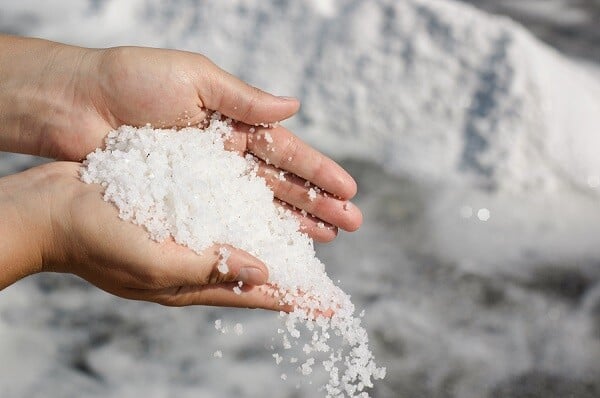
Kyle Epema
Victoria
What is Better? Chlorine, Saltwater or Mineral Pools
Which usually boils down to “I don’t want to get red, irritated eyes like I used to at the local community pool”. Or “Does one type keep my pool water cleaner and healthier?” Fair enough.
Let’s start with why you need chlorine in your pool. Chlorine kills the bacteria, algae and other yukkies (highly technical term!) that will be in your pool. It is why there is chlorine in our tap water and usually in bleach too. It keeps your water sanitised and safe and to swim in. Noticed the neighbours pool has gone green? Not enough chlorine! There are three ways to chlorinate your pool that we will talk about here - chlorine, salt or minerals.
If you would like to know more about freshwater pools, please click here to read our freshwater pool blog.
Chlorine
Chlorine can be added directly to your pool water either as a dissolvable tablet, a liquid or in granular form. If you used to see your Mum or Dad throwing strong smelling stuff from a bucket into your pool every other day in summer, you had a chlorine pool. As it is a manual process, the challenge is maintaining a stable level of chlorine.
When a dose is added, chlorine levels peak and then slowly reduce until more is needed. If you were swimming and your eyes became red and irritated, your hair smelled funny and your bathers had faded, you were in a chlorine pool that had been recently dosed. In summer, with kids in the pool every day, daily chlorine testing and dosing is usually needed.
You might be thinking “There must be an easier way?” – Well, enter the saltwater chlorinator!
Salt Water
Saltwater chlorinators work by converting salt added to your pool water, into pure chlorine. A salt cell next to your pump and filter produces a continuous bacteria-killing supply of chlorine while the pump is running. It is like being the manager of your own chlorine factory without ever having to touch a bottle or tablet of chlorine. Your pool water will feel softer without the eye irritation and strong smells as your chlorine levels won’t peak and trough. This is why almost all backyard pools bought in the last 20 years are saltwater pools.
Pool salt is cheap and normally can be bought in 15kg and 20kg bags. You will spend around $100 to $150 on salt per year depending on your pool size. No need to clean out the local supermarkets supply of table salt! Phew! Your pool will not taste like the ocean either. There is not enough salt in the water to taste it.
While pool salt is cheap, a quality Australian made, entry level, self cleaning (meaning the salt cell) automatic chlorinator will cost between $1,000 and $1,800. A model that can be controlled from your smart phone and measures water pH, water santisation levels and can automatically adjust dosage can be up to $3,000. With the money saved on chemicals and time maintaining your pool, you will be in front financially in a year or two no matter what you choose. Our fibreglass pool kits come with Australian Made Astral equipment and we have a full range depending on your budget.
Warranties range between 2 and 5 years. Check to see if they are full warranties or prorated. After about 3 to 5 years, you will need to replace the salt cell which will cost between $300 and $600.
As saltwater chlorinators are fully automatic you need to keep less of an eye on your chlorine levels compared to a traditional “add the chlorine in manually” pool. We humans can be a little on the lazy side at times which means we are tempted to set and forget. You will still need to check your chlorine levels regularly. Too much chlorine can damage your pool and equipment and too little will invite an algae bloom.
Mineralised
The solution to reducing the slight drying feeling of a saltwater chlorinated pool is to mineralise your pool by adding potassium and magnesium. Potassium is a natural moisturiser. Magnesium gives your water a soft, silky feel and also acts as a natural sanitising agent.
Us humans absorb around 400ml to 500mls of pool water per hour of swimming until we get water logged (otherwise known universally by kids as "granny hands"). The benefits of magnesium on hair, skin and muscle health are well established and plenty of swimmers prefer to be absorbing minerals rather than chemicals.
Check to make sure the minerals are farmed and rated “food grade” so you know you are getting the highest quality and concentration for your hard earned money. The idea of minerals from the "Dead Sea" is pretty enticing as it sounds so natural. Being natural is the issue. The quality, amount of contaminants and concentrations vary with every bag as it is naturally produced.
While magnesium and potassium are different to pool salt (sodium), they are also salts. You can mineralise your pool using a standard saltwater chlorinator. This is the lowest-cost way to mineralise your pool as you don't need to replace your saltwater chlorinator.
When first adding minerals to the pool after installation, the cost of the minerals will be between $300 and $1,200 depending on the size of your pool. A rule of thumb is 40kg of minerals per 10,000 litres of water. You will need to top up your mineral levels as you would a saltwater pool. On average, this will be a 10kg bag every 8 to 12 weeks costing around $50 to $60 per bag.
Rohan |
Complete Fibreglass Pool Kits
Think of this like air-conditioning in your car. Manual chlorine pools are like manual temperature and fan control knobs on your dashboard. Constant clicking up and down to get the temperature right. If you have digital temperature settings, your aircon will automatically adjust the fan speed and temperature to keep a steady temperature. That is the same as a saltwater pool. Go all in with airconditioned seats for extra comfort, welcome to a mineralised pool
.jpg)
Nicki Herriot
Queensland
What Pump Do I Need? Single, Two, Or Variable Speed
You need a pump to circulate your pool water through the filter and chlorinator, to remove organic matter and particles that bacteria feeds off and to distribute chlorine and other added chemicals around your pool. Without a good pump, it is like half stirring the milk and sugar in your coffee. Seeing this is not Pump School, how about we keep the technical stuff short?
Your pump will push out a set number of litres per minute (LPM). Multiply that number by 60 (minutes per hour), then divide that into the total litres in your pool to get the number of hours to run your pump per day. This will circulate the entire volume of your pool 1.5 times each day which is what is required during an Australian summer.
Like a short cut? As a general rule, 8 hours per day in summer will do the trick and about 4 hours per day if the pool is not being used in winter. Got it? Let’s go pump shopping!
The first step to pump-buying glory is to understand how your pool uses your pump. Most buyers don’t realise that everyday filtration only needs a low flow rate compared to running a suction cleaner, manually vacuuming a pool or backwashing a media filter. Filters work better at lower flow rates as the water passes through your filter with less turbulence and collects more particles.

Single Speed Pumps – Low Energy Efficiency Rating
These pumps only run at one speed – full power. They have been in use for decades and work perfectly well. They were invented before power costs became a talking point and pools didn’t have heaters, water features and spa jets.
They range between in size 140 and 500 LPM depending on your pool size. If your pool needs 300 LPM to properly backwash the filter and run the pool vacuum and only 100 LPM for daily filtering, you will end up running a 300 LPM pump 8 hours day.
This is the main reason why pool pumps are the second highest power user in your house behind air-conditioning.
Many people tend to buy the smallest pump they can get away with to keep the power bills down. With an undersized pump, when your pool is being used constantly in summer, you will need to run the pump longer to keep your water clear and sanitised. Not only will this wear the pump out faster, any money saved buying the pump will disappear with higher power bills.
Single speed pumps are the cheapest to buy initially. However, they are often the most expensive when you add in power costs over a year or two. If a single speed pump suits your budget, go for it, however choose a quality Australian made brand. A cheap single speed pump ($500 to $800) will be noisy and need to be replaced earlier than a quality pump ($800 to $1,300). A good way to gauge quality is to compare how loud (decibels) the pump is when running.
Two Speed Pumps- Average Energy Efficiency Rating
As we now know, pumps do not need to operate at the maximum LPM rate to maintain a healthy and sanitised pool. Circulating water can be done at 10-15% of your pumps flow rate. Two speed pumps solve this problem. They have a low speed setting for daily circulation and filtering and high speed setting for running a manual vacuum or backwashing a media filter.
While more energy efficient than their single speed friends, the two speeds are fixed so it is important to get the right pump for your pool. If the low speed setting is too low, you’ll need to run it for longer which wipes out the power savings. A two speed pump will cost around $200 to $300 more than an equivalent single speed pump.
Variable Speed Pumps– Very High Energy Efficiency Rating
A variable speed pump allows you to have multiple speed settings (high, medium, low) that you can program in. Backwashing the media filter needs a quick push button change to the high speed setting. Job done, select “low” speed for daily filtering. As filtering is going to be the most frequent use of your pump (90%), the energy savings on low speed will give you a kid in a lolly shop type smile. You will reduce your annual power use by around 85% and your pump will last years longer than a single speed pump. Cha-ching.
The new generation of variable speed pumps achieve up to a 9/10 star energy efficiency rating and operate quietly on all speeds. (You’ll be on the neighbours Christmas card list now!) Variable speed pumps cost more initially, however your bank account will thank you after a year or so.
Key Takeaway – If you are thinking of buying a single speed pump for the low initial cost, you will spend a lot more in running costs than you save on the purchase and will need to replace it earlier as they work so hard. If energy efficiency and lower annual running costs are important to you, a variable speed pump is your best bet if you can afford the higher upfront costs.
We often recommend delaying a non-essential accessory to help cover the cost. After a year or so, you will have the spare money from saved running costs to pay for the delayed accessory. Win/Win!
Rohan |
Complete Fibreglass Pool Kits
Have a look over your power company's website to see if they offer power rebates for energy-efficient pumps. Plenty do, and it's a phone call to change companies these days if yours doesn't.
Another resource is www.energy.gov.au/rebates Your local council might also be offering.
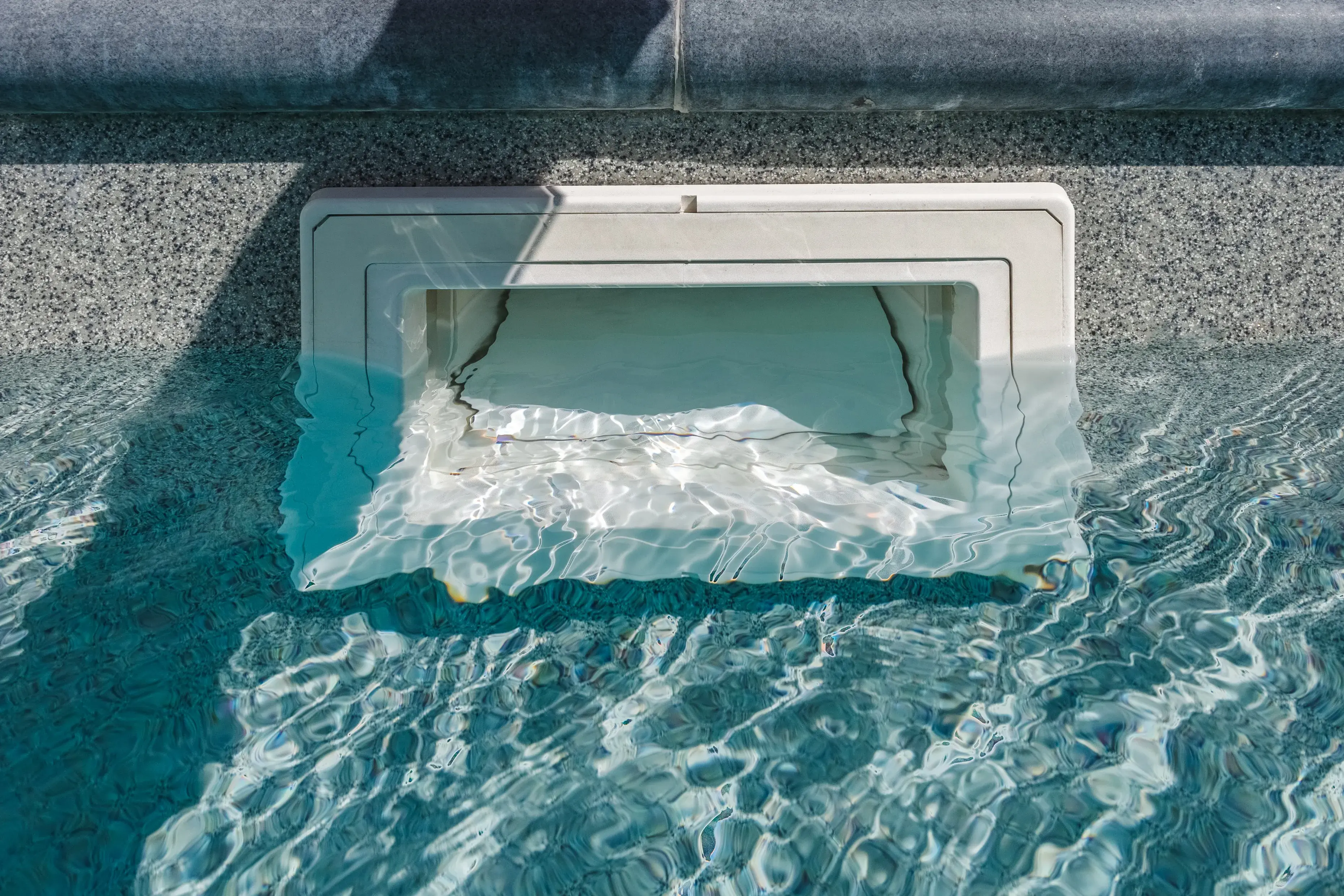
Wyn Heys
South Australia
What is the Difference Between a Media Filter and a Cartridge Filter?
Filters remove the organic matter and microscopic particles in your water that bacteria and algae like to feed on. Getting the right filter will mean the difference between safe, low maintenance, sparkling clear water or being on a first name basis with your local pool chemical shop constantly trying to fix water quality problems.
Ok, so the basics first. Your pump will draw water from your pool through the skimmer box and into your filter. This water is forced through either sand, glass or a mesh cartridge which traps the unwanted particles. Clean water is pumped back into your pool through the return jets (sometimes called “eyeballs”). It is very important that you match your filter flow rate to the pump flow rate otherwise filtering efficiency will be seriously impacted along with the longevity of your filter.
Media Filters –Sand
Unfortunately, we are not referring to a new app that filters out unwanted media ads on your smart phone. Media refers to what you choose to fill your filter with – either sand or glass. As you can see from the image, the filter bowl holds a fair amount of media (usually 80kg or 120 kg depending on pool size).
20 grade silica (sand) has been used for decades, hence the older term “sand filters”. Under a microscope, each particle of sand has jagged edges. It is these edges that capture the tiny particles in your water. Over about 5 years these edges are worn smooth, losing their filtering ability and need to be replaced. A mid- sized sand filter will hold around 120kg of sand which costs around $140 to replace. At an average of $28 per year, it is very cost effective.
Media Filter – Glass
You can also use crushed glass (glass media) rather than sand. Why? The glass particles are smaller and harder than sand so they capture smaller particles (down to 5 micron) from your water that are missed by sand. It takes around 7 years for glass to be worn smooth and needing to be replaced. 120kg of glass media will cost around $240. At an average of $34 per year, it will not break the bank however it is more expensive than sand. If you are expecting your pool to be continually full of kids (called high bather load), glass will do a better job of keeping your water crystal clear compared to sand.
Don’t they waste a lot of water? To maintain a media filter, the media needs to be cleaned every month in summer (or when the pressure gauge needle on your filter is pointing to red) by backwashing. Backwashing, as seen below, reverses the water flow direction through your filter which stirs up the media (it is like shaking a snow cone) releasing dirt and particles. The dirty water is discharged into your sewer line or soak wells. A backwash is simple to do, takes a couple of minutes. Sand media discharges around 300 litres of water per backwash whereas glass is around 180 litres.
Media filters generally cost between $600 and $1,200 with top end models up to $2,100. It is important to check what the outer shell is made from. If your filter will be continuously exposed to the sun, lean towards a fibreglass shell over injection mould plastic. Fibreglass is much more durable in the elements and will last a lot longer than plastic under the harsh Australian sun.
Cartridge Filters
If space for your pump, filter and chlorinator is tight, a cartridge filter has a much smaller footprint than a media filter. Inside is a cartridge that is usually several layers of fine mesh (like flyscreens however with much smaller holes). This mesh can filter smaller particles than a sand media filter and works much the same. Water is pushed under pressure through the mesh which traps the particles.
The cartridge can be easily removed and needs to be cleaned once per month initially. If you notice the cartridge is really dirty, you will need to clean it fortnightly. Or, every two months if it’s not that dirty after a month. High bather loads and pools with trees close by normally need more frequent cleaning. Cleaning is a bit more messy than media filters however still easy enough. Give the element an overnight soak in a cleaning solution and a good wash out and you are done. We recommend having two cartridges so your pump and filter can still run while one cartridge is being cleaned.
Cartridge filters cost between $500 and $1,100 on average, with top end models up to $2,200. Replacement filters cost between $100 and $300. If regularly cleaned, they need to be replaced every 3 to 4 years. Without regular cleaning, you might replace them annually.
Rohan |
Complete Fibreglass Pool Kits
Cartridge filters have been popular over the last ten years. However, there is a consistent trend of pool owners replacing them with media filters after a year or two. Why? time and ongoing cost. Cartridge filters on medium and large-size pools or high-bather-load pools require a lot of cleaning. Owners want time in the pool, not working on it.
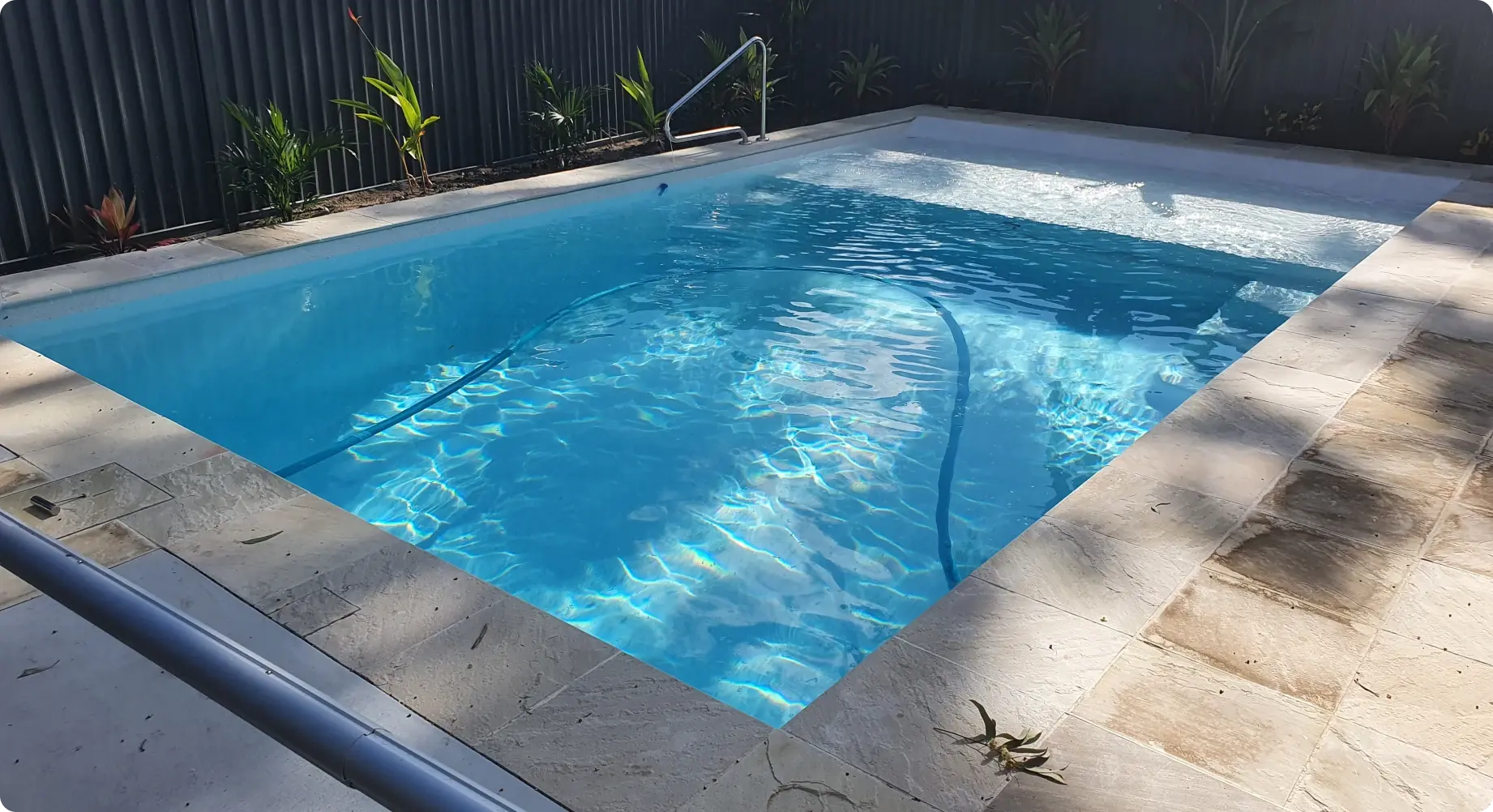
Sharon McGrath
New South Wales
The Essential Big Three
No matter what else you buy for your pool, the pump, filter and chlorinator are what we call the Big Three. They are the heart (pump), kidneys (filter) and brain (chlorinator) of your pool. An unbelievably good pump and chlorinator combined with an underperforming filter will give you ongoing water quality problems. That is great news for the local pool supply shop as you will be buying loads of clarifying chemicals and algae removal potions from them.
Not so good news for your bank account and spare time. It is essential that you have the right pump and filter flow rate for your size pool and a chlorinator that will produce enough chlorine to keep your pool water safe to swim in.
Be wary of a pool builder or a pool kit supplier who includes cheap and/or undersized equipment to make the overall cost of your pool look more affordable. Always ask them to justify their selection with hard facts around flow rates, power use and durability
If budget is tight, as it often is, spend as much as you can on the Big Three as possible and delay some of the other goodies. The water feature, extra lighting and heating can all be pre-plumbed when your pool goes into the ground ready for connection down the track.
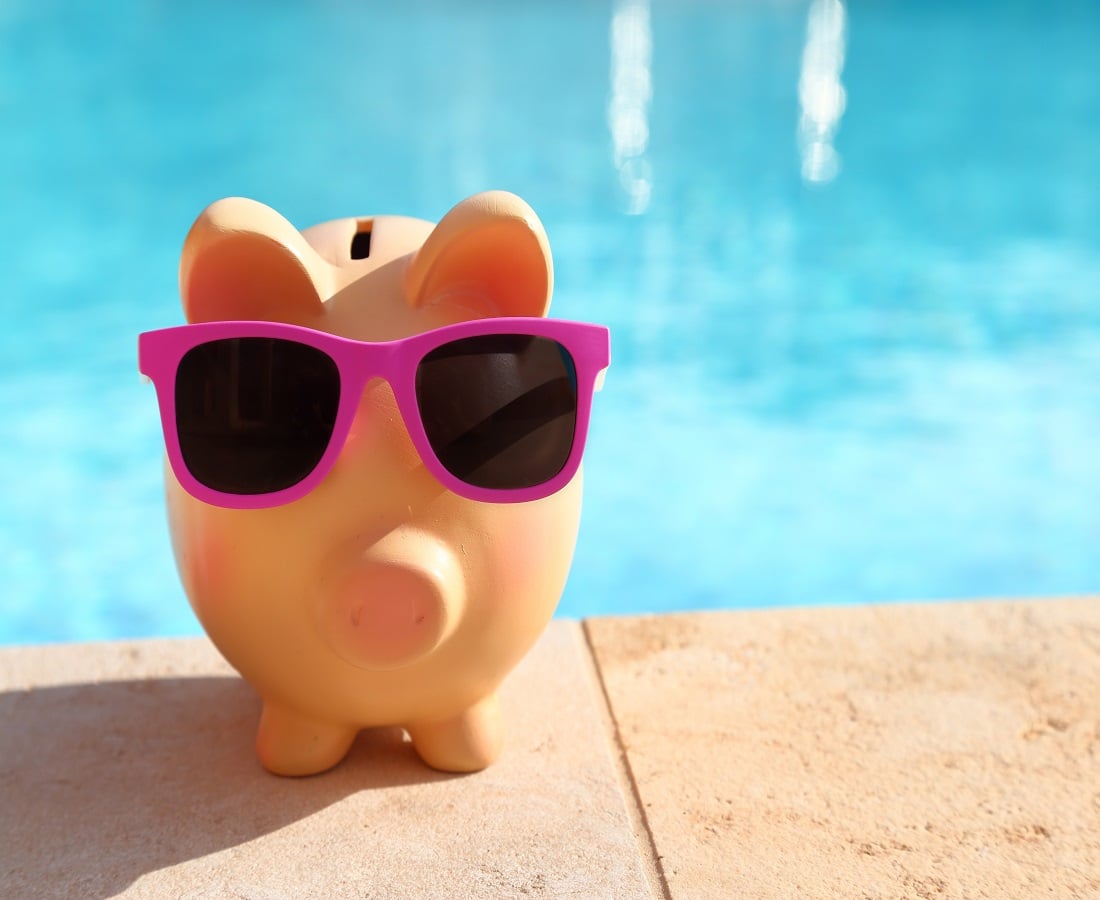
Hayley Ryan
South Australia
Are Gas and Electric Pool Heaters Expensive to Operate?
This Depends On What You Ask:
- Do you want to swim right through winter (less affordable) or extend the swimming season by a couple of months (more affordable)?
- Do you want to take the chill off with 26 degree water temperature (more affordable) or want warmer 28+ degree water (less affordable)?
-
Is your pool concrete (less affordable) or fibreglass (more affordable)?
- Is your deep end over 2m deep (less affordable) or a standard depth of around 1.7m (more affordable)?
- Do you have a quality pool blanket in conjunction with your heater (more affordable) or no pool blanket (less affordable)?
- Are you on mains gas (more affordable) or bottled gas (less affordable)?
- Do you live in a warmer climate like Brisbane (more affordable) or cooler climates like Melbourne (less affordable)?
There are a lot of variables that make a significant impact on the operating cost of your pool heater. If you heat your pool, you will notice a difference in your gas or power bill. Most pool owners use heaters from mid-spring and from the end of summer to mid-autumn and heat to a more efficient 28 degrees. Adding 2 degrees, up to 30 degrees, can add 30% to the operating cost.
A quality (at least 500 micron and not the junk with a 2 year warranty on eBay) pool blanket makes a huge difference. At around $1,000 for a pool blanket and roller, you will save at least 50% of your annual heating bill which will offset the blanket cost quickly. A pool blanket will also naturally heat your pool water by up to 8 C which reduces how many heater running hours you need to hit your ideal temperature. Are they essential? No. However, without a pool blanket, it's like trying to heat your house with all of the doors and windows open. It’s possible if you are happy with a huge heating bill and double the upfront cost for a larger heating unit.
We’ve yet to find a pool owner with heating that regrets the decision however you need to make sure it is right for you.
What Are The Options?
Gas Heater
A gas heater is just like your instant gas hot water heater at home. Water passes through the internal piping exposed to gas flames which rapidly heats the water. A pump then pumps the warm water into your pool. As a general rule, allow around 24 hours to achieve a 12 degree temperature increase. Gas heaters run on Natural Gas (mains gas) or Liquid Petroleum Gas (LPG bottles) which is the same as the gas used in your house If you are on gas bottles rather than mains gas, consider a heat pump as gas heaters can use up gas bottles quickly.
Like any heater (inside or out), energy efficiency is paramount. Gas heaters have a much higher litre per minute (LPM) rate than heat pumps which makes them gas hungry. A cheap heater won’t be efficient and will cost you more with higher gas bills. A quality gas heater with a five year warranty will relieve your bank account of between $3,800 and $7,700 depending on pool size.
Heat Pumps
Heat pumps are very similar to your reverse cycle air-conditioning at home. A condenser uses heat from the outside air to warm up your water. The LPM output rate is much lower than gas so heating up times are also longer. Allow 48+ hours for a 12 degree increase.
With the invention of heat pump inverters (the pump speed cycles down as the set temperature is achieved), they are now energy efficient. How efficient? Up to 20% cheaper to operate than gas.
Heat pumps can also be remotely controlled through your smartphone depending on the brand you choose. Quality brands will offer full warranties up to 3 years rather than “1 year on labour, 2 years on parts and 25 years on the heat exchanger”. Entry level inverter heat pumps start around $2,000 and can go as high as $13,000 for a monster sized unit that could heat the whole neighbourhood (ok, that’s an exaggeration).
What else impacts the size of the heater you need? How much sun your pool receives in summer, wind, elevation and the colour of your pool. Make sure your heater supplier is using a heating calculator that includes these points and is based on the weather in your postcode. Using a “Melbourne” table for rural Victoria is not going to be accurate.
What about solar heating? How much does it cost to run a heater in each State based on the different weather? Great questions - click here to read our full blog that explains all heating options in a lot more detail.
Rohan |
Complete Fibreglass Pool Kits
If you are looking to extend your swimming season by a couple of months when the outside temperature is still relatively warm, a heat pump will work nicely and save money on operating costs. If you want to be swimming in the middle of winter in Melbourne at a nice 28 degrees, go with gas
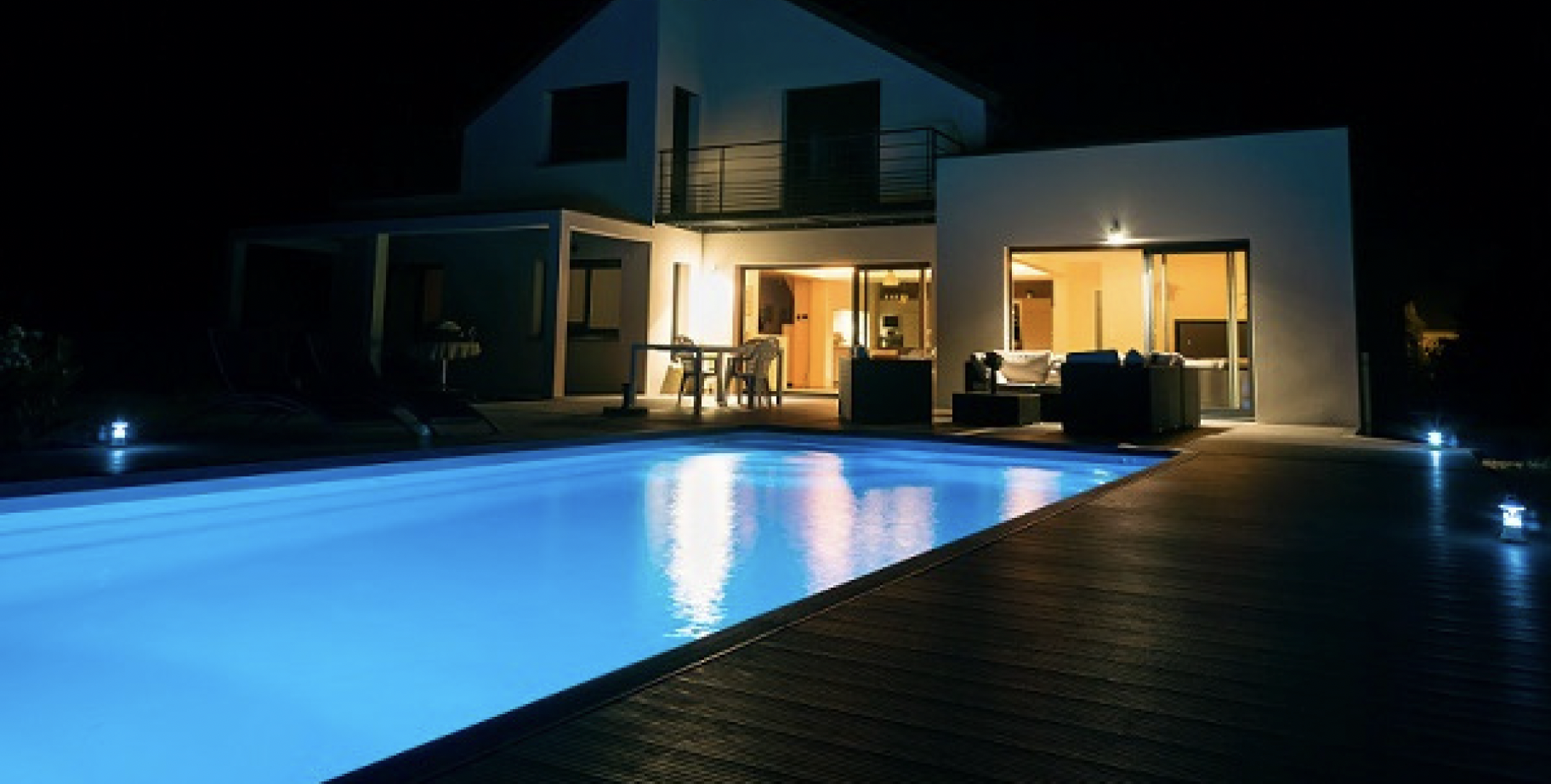
Nick Toutountzis
Western Australia
What’s the Difference Between Halogen and LED Pool Lights?
Back in the dark ages when we were kids, pools had a single halogen pool light for night swimming. These days, pool lighting is as much about the nighttime light show as it is the swimming.
Halogen lights are almost extinct. They are very power-hungry and globes need replacing every 2,500 hours or so. As light emitting diode (LED) lighting has become more affordable over the past 5 years, pool owners almost unanimously install LED for several reasons – they are very energy efficient (up to 80% less power use of a halogen), they are very compact and can change all sorts of colours depending on the look you want for that particular day. It is like Christmas lights for your pool.
LED pool lights have a very long operating life of up to 45,000 hours (the plastic casing and seals will fail long before the globe though). You can opt for flush mounted LED’s where only the front face of the light is visible. Or you can go for surface mounted LED’s where the globe and surrounding mount plate are visible. It is a personal preference and there is no difference in effectiveness.
It cannot all be light show and no shadows though. LED lights cost between $450 (surface mount) and $720 (flush mount) each plus the cost of a transformer (around $210) and an electrician to connect them to power. If you can part with that upfront, you will have a set-and-forget light fitting offering a rainbow of colour settings without the hassle of globe replacement. Full disclosure – we do not sell halogen lights. We think it is like offering horses for sale when cars first started on the roads. We do sell retrofit LED kits if you want to replace your horse, we mean halogen light, though.
Are LED Pool Lights Safe?
They run off 12 volts (think 12 volt battery) which is perfectly safe.
How Many Lights Do You Need?
If your pool is over 7m long, the general consensus is 2 lights. Dark internal pool colours will absorb more light than a lighter colour which might mean a second light if your pool is less than 7m long. If you would like tips on where to position your pool lights, remote control options and more, click here to read our blog
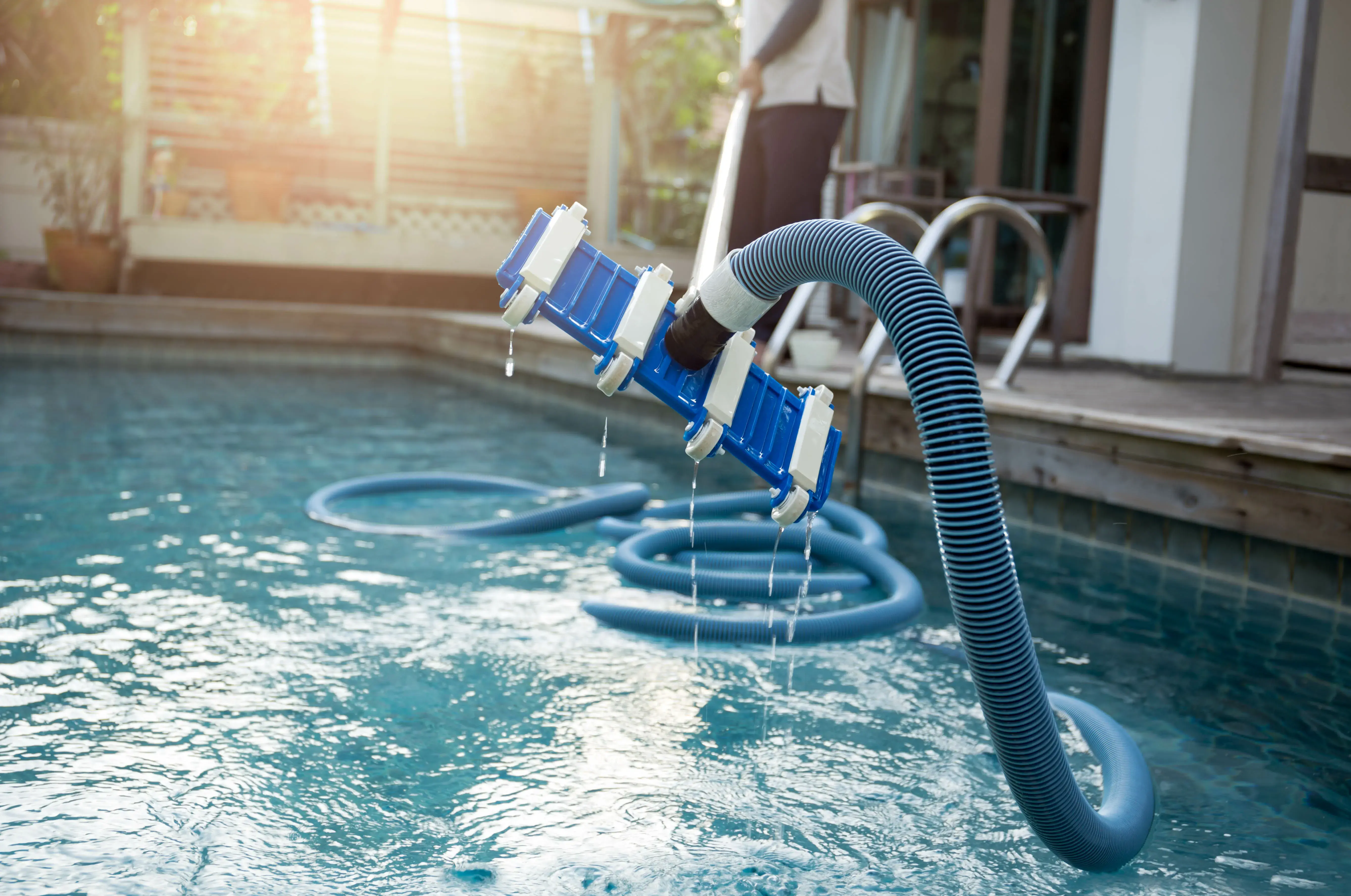
Francie Cianguru
Victoria
The Difference Between a Manual Vacuum, Suction Cleaner and Robotic Cleaner
Manual Cleaners
These are like your home vacuum. A vacuum head with rollers is attached to an extendable pole so you can push it around your pools floor. Suction comes from connecting a hose to the vacuum head and your skimmer box and turning on your pump. Just add a human (not usually the kids who actually use the pool!) and 30 minutes later you should be done. For the best water quality, manually brush down the walls and allow the particles to settle for an hour before vacuuming. If you have a variable speed pump, run your pump on high while vacuuming.
Suction Cleaners
Suction cleaners are an economical semi-automatic version of a manual vacuum and are set up the same way. The difference is you can throw it in the water and walk away. When the pump comes on, the cleaner will move around the pool floor and up the walls vacuuming everything in its path. As it moves around in random patterns, sections often get missed which need manual vacuuming or a broom down.
Plenty of people leave their suction cleaner in the pool for weeks on end which voids the warranty. Plastic and rubber seals do not like long baths in pool water. While saving you time, leaving it in the pool and connected will mean your pump will continuously run on the highest power use setting. It is best on your cleaner and pump if you remove the cleaner after each clean.
As the cleaner is attached to the skimmer box, leaves and other debris that would normally be skimmed from the surface will end up on your pool floor. The volume of water through the filter drops as well so monitor your water quality initially and increase your pump running time if it is becoming cloudy. Compared to manual vacuuming, you will be relaxing by the pool in no time.
Quality suction cleaners range between $680 and $1,300. You will annually spend around $100 on consumables that wear out like diaphragms, retaining rings and tracks.
Robotic Pool Cleaners
We so want to make a Lost in Space reference here. Alas, no. If you are looking for a cleaner that will learn the shape of your pool, can be controlled from your smartphone and is completely independent of your filtration system, you might start mumbling “top of the range robot pool cleaner” in your sleep.
Traditional robots plug into a standard power point. A transformer in the unit converts the power to a safe low voltage level which in turn powers the wheels or tracks that move it around your pool. (Yes, it’s a long power cable!).
Being low voltage, they are very economical on electricity use. As they do not rely on your pump and filter to operate, your skimmer box will collect surface debris and your pump can run on its lowest power setting for daily operation while your robot cleaner goes to work.
If plugging in and packing away power cables doesn't float your boat, consider a battery-powered robot (yep, no cables). The market is currently flooded with cheap Chinese brands that are total rubbish. With battery-operated robots, you get what you pay for. Look past the fancy brochure and cool looking robot and only buy a robot that offers 500 operating hour battery warranty backed by a major brand. That is your sign of quality. A long warranty from a new company without an office in Australia isn't a good sign.
The robot vacuums straight into its own filter basket (like a house vacuum) and will suck up all sizes of debris. Robots can scrub your floor, walls and waterline saving you from manually brooming your pool. As the debris is not going into your filter, you’ll notice your filter will need less backwashing or cartridge cleaning and your chemical consumption will drop.
Just like suction cleaners, leaving your robot in the pool for days and weeks on end will void the warranty.
The downside is with all that extra time relaxing next to your pool, you’ll be able to think about what your new robot friend cost. Quality entry-level models that scrub the pool floor, waterline and walls will start at around $1,200. All the bells and whistles functions are up to $2,800. Start dropping Christmas present hints early!
Rohan |
Complete Fibreglass Pool Kits
Whether it is you, a pool cleaning service or the house guest, someone has to vacuum the pool regularly. Even in winter when there are icebergs in the water. Manual vacuums work just fine. If the budget is tight, start there and look at upgrades later on.
The decision to upgrade to a suction cleaner or robotic cleaner comes down to whether you are happy to trade a higher upfront cost for less time maintaining your pool. If you can invent a way that is really low-cost and fully automatic, let us know, and we’ll all be rich!
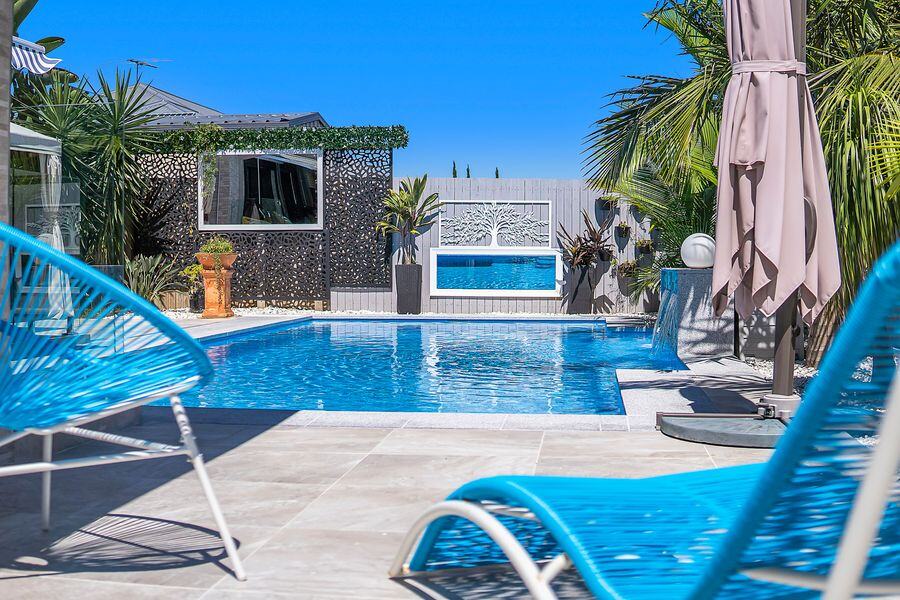
Barry Read
Queensland
What is a Handover Kit and What is In It?
Quality fibreglass pool kit companies will include a pool handover kit in their quote. Everything you need to keep your pool clean of debris and to know your water is safe is in your handover kit and is essentially a starter pack to get you on your way to a clean and safe pool.

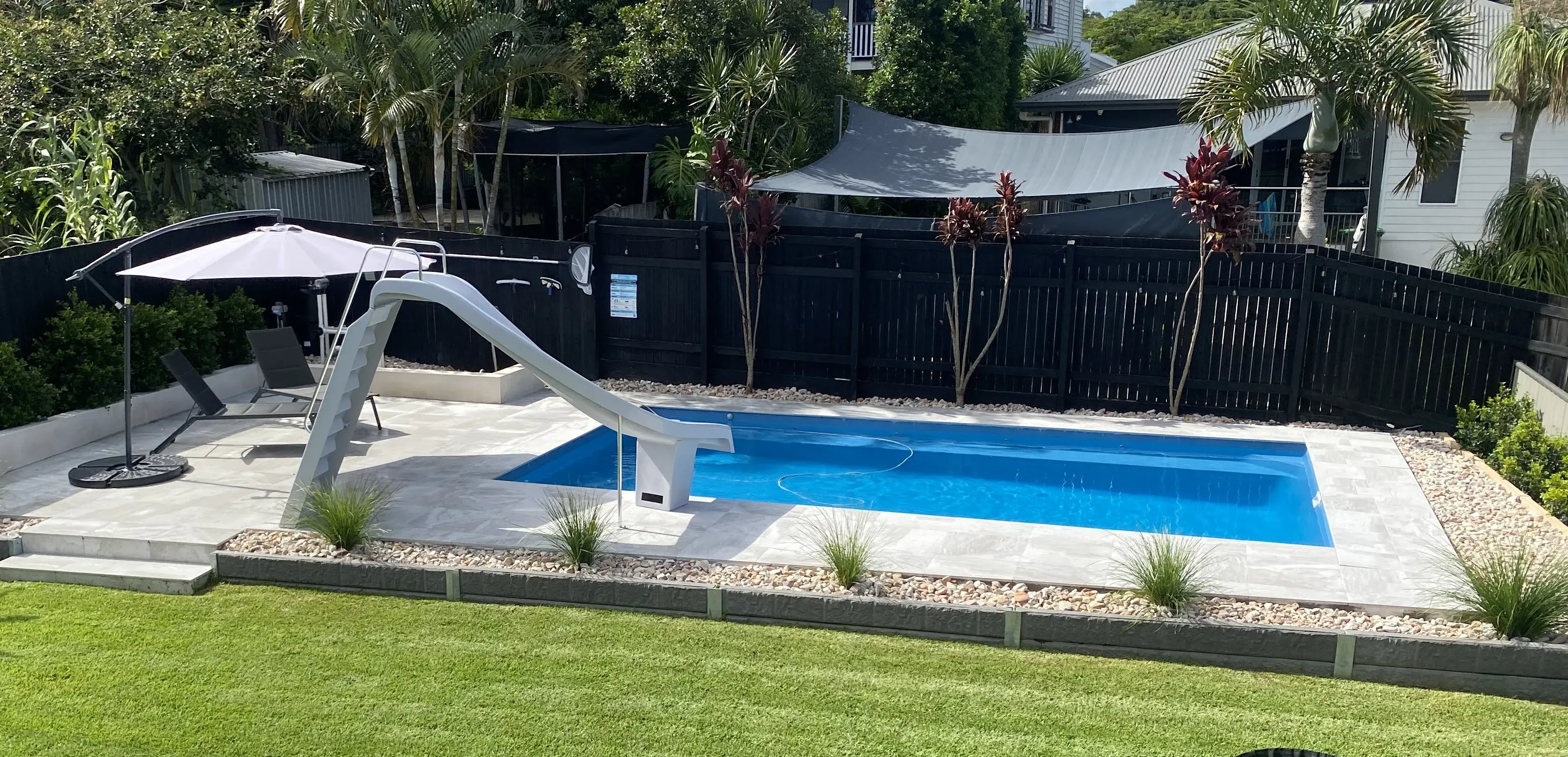
Stacey Horgan
South Australia
Is That Everything? What About the Other Stuff?
Call us cheeky however the title is “The Essentials You Must Know Before Buying A Pool”. What we have discussed up to here is, in our humble opinion, the essentials 90 % of pool buyers think about when first buying a pool.
Everything else is icing on top that is nice to have however you can survive without.
What’s Included in the Icing on Top List?
- Water Features
- Automation
- Controllers
- Chemical Dosing Systems
- 4in1 water test kit
- UV Sanitisers
- Spa Jets and Spa Blowers
- Deck Jets
- Pool Blankets and Liquid Pool Blankets
- Permanent Pool Fencing
Here at Complete, we can help you with all of the above items except for pool fencing.
Get in touch and let us know how we can help.
If you would like to read through our full blog library, head to https://learn.completefibreglasspoolkits.com.au/ and read away!
The Final Word
As you can now appreciate, there isn’t a “one package” or “one size” fits all solution for you and your pool.
The location of your pool in your yard, the State you live in and why you are installing a pool is completely unique to you. Therefore, your equipment quote should be completely unique as well.
The best pool is one that is within your budget and brings you the joy and pleasure you wanted. It is a rare occasion that a pool is removed from a backyard and for good reason. They bring immense value for money, will increase the value of your home and will transform how you live in your home. If you get the equipment essentials right, your pool will be low maintenance from the beginning.
Rohan Taylor
Author
Join our weekly email
Sign up for the very best DIY pool content, delivered once a week.
We care about your data in our privacy policy.
What’s Next

Western Australian Poolscapes: Native Plants and Water‐Wise Designs
In the height of a Perth summer, the idea of stepping into a backyard pool feels more like a nece...

Outdoor Entertaining + Fibreglass Pool: Designing a Unified Backyard Space
The New Heart of the Home Is Outside A growing number of Australians are re...

Choosing the Perfect Fibreglass Pool Colour: A Guide to Getting the Look You Want
You’ve sorted the shape and size. Phew! Now you’re staring down the most personal (and permanent)...
.jpg)
Fibreglass Pool Disadvantages: What to Know Before You Buy (And What to Avoid)
When it comes to backyard swimming pools, fibreglass options often come out on top. They are fast...
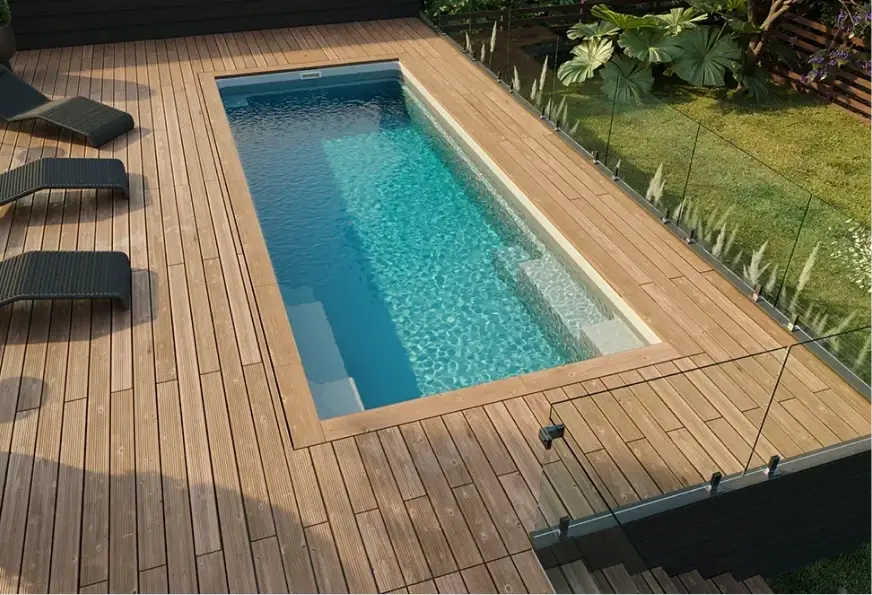
Fibreglass Swimming Pool Basics: A Quick Q&A for First‐Time Buyers
So, you’re tossing around the idea of getting a fibreglass swimming pool? Nice one. But let’s be ...
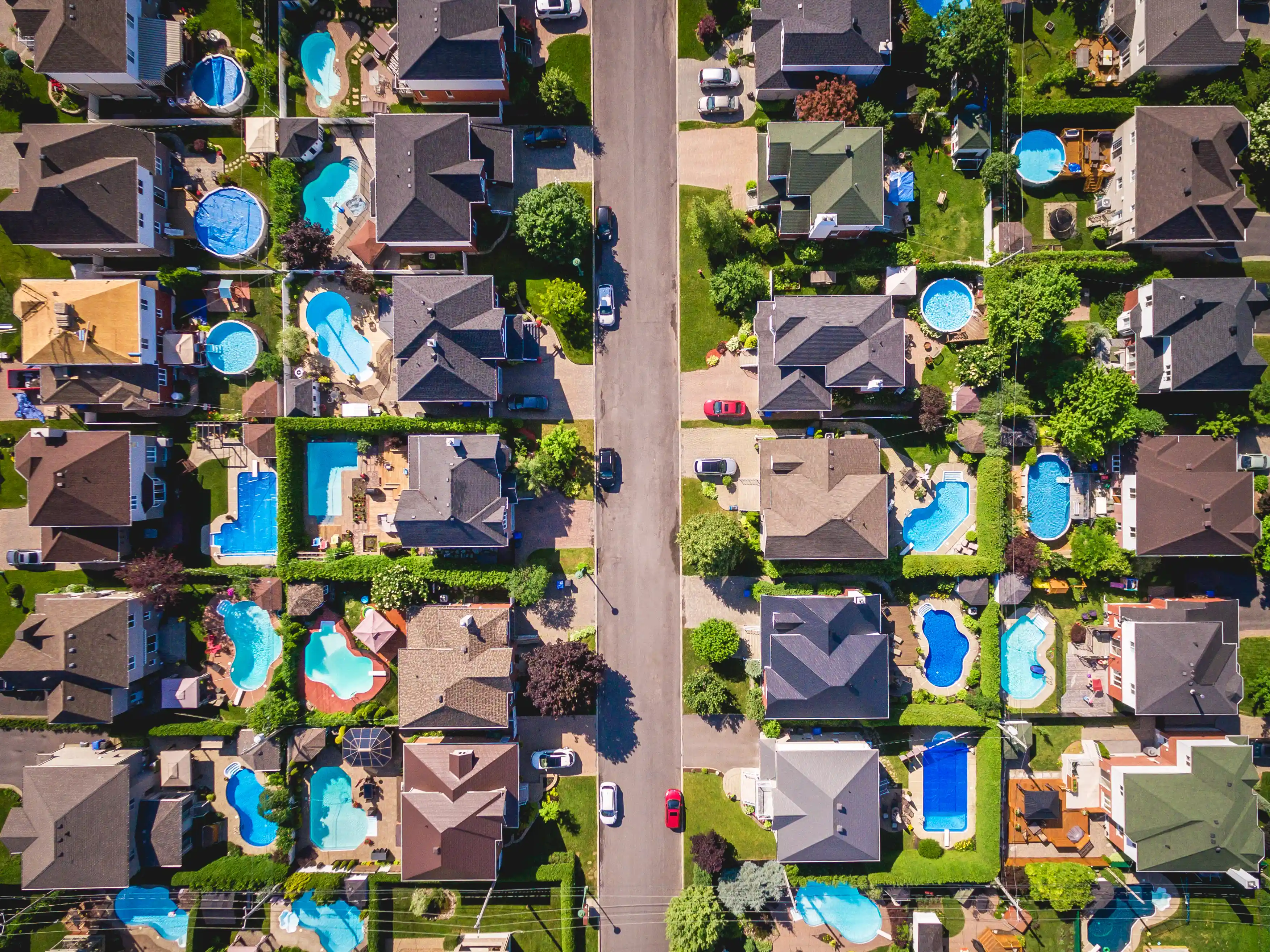
Fibreglass Pools: Navigating Victoria’s Council & Safety Requirements
Thinking about installing a pool out the back? Cracking idea.
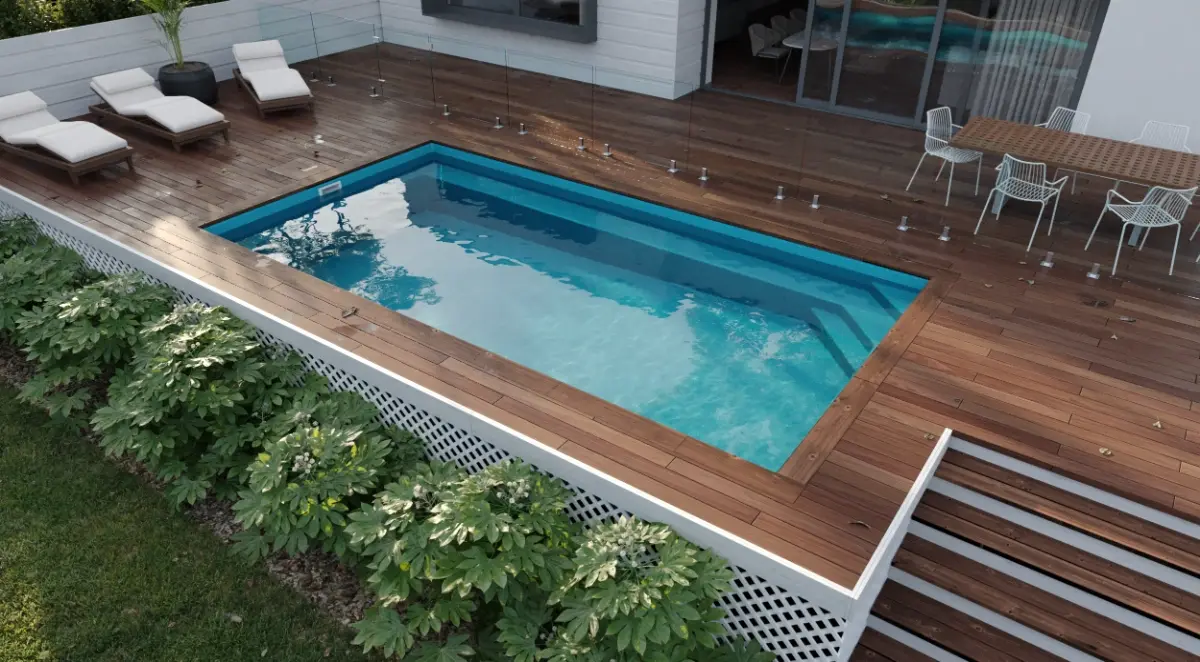
Fibreglass Above Ground Pool vs. In-Ground: Which One Is Right for You?
So, you’ve made the call to put in a DIY fibreglass pool. Good on you. It's one of the smartest w...
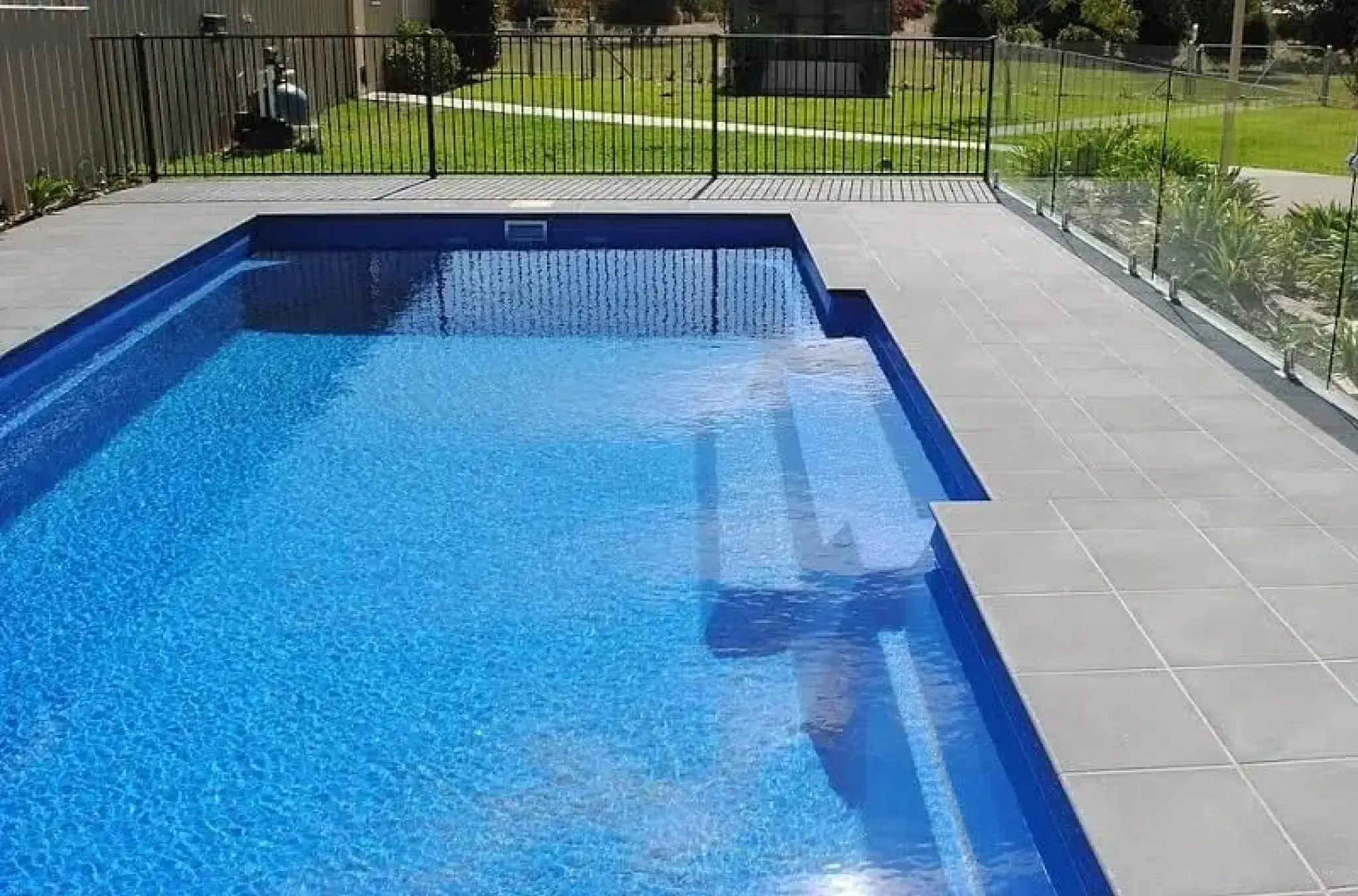
27 Must-Know Terms for New Pool Owners
Thinking about joining the world of fibreglass pools? You might feel like you’ve stumbled into a ...









_converted.webp?width=686&height=448&name=Daydream%209.2m%20AquaGuardTM%20Quartz%20Ultra%20Mid%20Blue%20Shimmer%20Finish%20Web%20(1)_converted.webp)












